Related Research Articles
1998 KY26 is a nearly spherical sub-kilometer asteroid, classified as a near-Earth object of the Apollo group. It measures approximately 30 meters (100 feet) in diameter and is a fast rotator, having a rotational period of only 10.7 minutes. It was first observed on 2 June 1998, by the Spacewatch survey at Kitt Peak National Observatory during 6 days during which it passed 800,000 kilometers (half a million miles) away from Earth (a little more than twice the Earth–Moon distance).

25143 Itokawa (provisional designation 1998 SF36) is a sub-kilometer near-Earth object of the Apollo group and a potentially hazardous asteroid. It was discovered by the LINEAR program in 1998 and later named after Japanese rocket engineer Hideo Itokawa. The peanut-shaped S-type asteroid has a rotation period of 12.1 hours and measures approximately 330 meters (1,100 feet) in diameter. Due to its low density and high porosity, Itokawa is considered to be a rubble pile, consisting of numerous boulders of different sizes rather than of a single solid body.
(52760) 1998 ML14 (provisional designation 1998 ML14) is a stony asteroid, classified as near-Earth object of the Apollo group and potentially hazardous asteroid, approximately 1 kilometer in diameter. It was discovered on 24 June 1998, by the LINEAR survey at the Lincoln Laboratory's Experimental Test Site in Socorro, New Mexico.
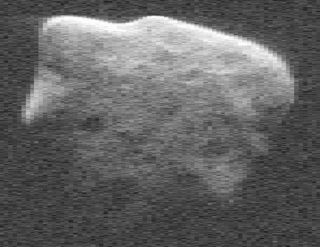
(53319) 1999 JM8 is an asteroid, slow rotator and tumbler, classified as a near-Earth object and potentially hazardous asteroid (PHA) of the Apollo group, approximately 7 kilometers (4 miles) in diameter, making it the largest PHA known to exist. It was discovered on 13 May 1999, by astronomers of the Lincoln Near-Earth Asteroid Research at the Lincoln Laboratory's Experimental Test Site near Socorro, New Mexico.

The Spacewatch Project is an astronomical survey that specializes in the study of minor planets, including various types of asteroids and comets at University of Arizona telescopes on Kitt Peak near Tucson, Arizona, in the United States. The Spacewatch Project has been active longer than any other similar currently active programs.

Hayabusa2 is an asteroid sample-return mission operated by the Japanese state space agency JAXA. It is a successor to the Hayabusa mission, which returned asteroid samples for the first time in June 2010. Hayabusa2 was launched on 3 December 2014 and rendezvoused in space with near-Earth asteroid 162173 Ryugu on 27 June 2018. It surveyed the asteroid for a year and a half and took samples. It left the asteroid in November 2019 and returned the samples to Earth on 5 December 2020 UTC. Its mission has now been extended through at least 2031, when it will rendezvous with the small, rapidly-rotating asteroid 1998 KY26.
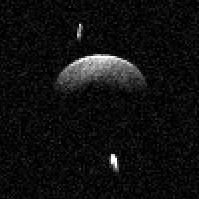
(153591) 2001 SN263 is a carbonaceous trinary asteroid, classified as near-Earth object and former potentially hazardous asteroid of the Amor group, approximately 2.6 kilometers (1.6 miles) in diameter. It was discovered by the Lincoln Near-Earth Asteroid Research project at Lincoln Lab's Experimental Test Site in Socorro, New Mexico, on 20 September 2001. The two synchronous minor-planet moons measure approximately 770 and 430 meters and have an orbital period of 16.46 and 150 hours, respectively.
13732 Woodall, provisional designation 1998 RC56, is a stony Vestian asteroid from the inner regions of the asteroid belt, approximately 4 kilometers in diameter. It was discovered on 14 September 1998, by the Lincoln Near-Earth Asteroid Research (LINEAR) team at Lincoln Laboratory's Experimental Test Site in Socorro, New Mexico.
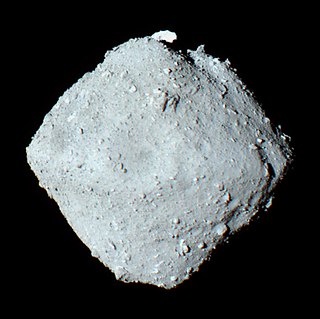
162173 Ryugu (provisional designation 1999 JU3) is a near-Earth object and a potentially hazardous asteroid of the Apollo group. It measures approximately 900 metres (3,000 ft) in diameter and is a dark object of the rare spectral type Cb, with qualities of both a C-type asteroid and a B-type asteroid. In June 2018, the Japanese spacecraft Hayabusa2 arrived at the asteroid. After making measurements and taking samples, Hayabusa2 left Ryugu for Earth in November 2019 and returned the sample capsule to Earth on 5 December 2020. The samples showed the presence of organic compounds, such as uracil (one of the four components in RNA) and vitamin B3.
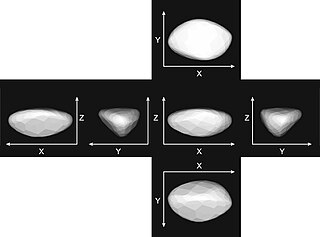
11351 Leucus is a mid-sized Jupiter trojan from the Greek camp, approximately 40 kilometers in diameter. It is a target of the Lucy mission, scheduled for a flyby in April 2028. The assumed D-type asteroid is an exceptionally slow rotator with a rotation period of 466 hours. It was discovered on 12 October 1997 by the Beijing Schmidt CCD Asteroid Program (SCAP) at Xinglong Station in the Chinese province of Hebei, and later named after the Achaean warrior Leucus from Greek mythology.

367943 Duende (provisional designation 2012 DA14) is a micro-asteroid and a near-Earth object of the Aten and Atira group, approximately 30 meters (98 ft) in diameter. It was discovered by astronomers of the Astronomical Observatory of Mallorca at its robotic La Sagra Observatory in 2012, and named for the duende, a goblin-like creature from Iberian and Filipino mythology and folklore. Duende is likely an uncommon L-type asteroid and significantly elongated. For an asteroid of its size, it has a relatively long rotation period of 9.485 hours.

(88710) 2001 SL9 (provisional designation 2001 SL9) is a sub-kilometer asteroid and binary system, classified as near-Earth object of Apollo group discovered by NEAT at Palomar Observatory on 18 September 2001. It measures approximately 960 meters in diameter, while its 2001-discovered minor-planet moon has an estimated diameter of 200 meters based on a secondary to primary mean-diameter ration of 0.28.
2001 AV43 is a very small, monolithic asteroid and fast rotator, classified as a near-Earth object of the Apollo group, approximately 30 meters (98 feet) in diameter. It was first observed on 5 January 2001, by astronomers of the LINEAR program at Lincoln Laboratory's Experimental Test Site near Socorro, New Mexico, in the United States. The presumed S-type asteroid has a rotation period of only 10 minutes. It has an exceptionally low MOID of 0.66 lunar distance (LD) and will approach Earth at 0.81 LD on 11 November 2029.

DESTINY+ (Demonstration and Experiment of Space Technology for INterplanetary voYage with Phaethon fLyby and dUst Science) is a planned mission to flyby the Geminids meteor shower parent body 3200 Phaethon, and sample dust originating from the "rock comet". The spacecraft is being developed by the Japanese space agency JAXA, and will demonstrate advanced technologies for future deep space exploration. As of 2023, DESTINY+ is planned to be launched in 2025.
(385343) 2002 LV, provisional designation 2002 LV, is a stony asteroid on a highly eccentric orbit, classified as near-Earth object and potentially hazardous asteroid of the Apollo group, approximately 1.5 kilometers in diameter. It was discovered on 1 June 2002, by astronomers with the Lincoln Near-Earth Asteroid Research at the Lincoln Laboratory's Experimental Test Site near Socorro, New Mexico, in the United States. The Sr-type asteroid has a rotation period of 6.2 hours and is likely elongated.
(154276) 2002 SY50, provisional designation 2002 SY50, is a stony asteroid on a highly eccentric orbit, classified as near-Earth object and potentially hazardous asteroid of the Apollo group, approximately 1.1 kilometers (0.7 miles) in diameter. It was discovered on 30 September 2002, by astronomers with the Lincoln Near-Earth Asteroid Research at the Lincoln Laboratory's Experimental Test Site near Socorro, New Mexico, in the United States. The K-type asteroid has a rotation period of 4.8 hours. It will make a close encounter with Earth on 30 October 2071.
16070 Charops (provisional designation 1999 RB101) is a Jupiter trojan from the Trojan camp, approximately 64 kilometers (40 miles) in diameter. It was discovered on 8 September 1999, by astronomers with Lincoln Near-Earth Asteroid Research at Lincoln Laboratory's Experimental Test Site near Socorro, New Mexico, in the United States. The dark D-type asteroid belongs to the 60 largest Jupiter trojans and has a rotation period of 20.24 hours. It was named after the Lycian soldier Charops from Greek mythology.
(172034) 2001 WR1, provisional designation: 2001 WR1, is a sub-kilometer near-Earth object of the Amor group, approximately 650 meters (2,100 feet) in diameter. The S-type asteroid has been identified as a potential flyby target of the Hayabusa2 mission. It was discovered on 17 November 2001, by astronomers with the Lincoln Near-Earth Asteroid Research at the Lincoln Laboratory's Experimental Test Site near Socorro, New Mexico, in the United States. The asteroid has a rotation period of 8.0 hours and possibly an elongated shape. It remains unnamed since its numbering in December 2007.
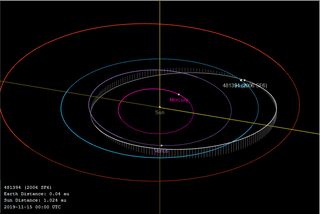
(481394) 2006 SF6 is a sub-kilometer near-Earth object and potentially hazardous asteroid of the Aten group, approximately 300 meters (1,000 feet) in diameter. It was discovered on 17 September 2006, by the Catalina Sky Survey at Catalina Station in Arizona. On 21 November 2019, it passed Earth at a distance of 11 lunar distances (0.0288 AU), which is the object's closest flyby for centuries. The stony A/S-type asteroid is highly elongated in shape and has a rotation period of 11.5 hours.
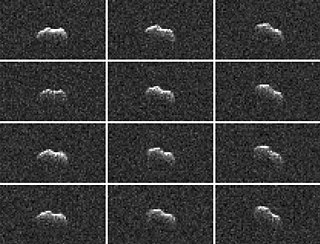
(231937) 2001 FO32 is a near-Earth asteroid classified as a potentially hazardous asteroid of the Apollo group. With an estimated diameter around 550 m (1,800 ft), it was discovered by the Lincoln Near-Earth Asteroid Research at Socorro, New Mexico on 23 March 2001. The asteroid safely passed by Earth on 21 March 2021 16:03 UTC from a closest approach distance of 0.0135 AU (2.02 million km; 1.25 million mi), or 5.25 lunar distances (LD). During the day before closest approach, 2001 FO32 reached a peak apparent magnitude of 11.7 and was visible to ground-based observers with telescope apertures of at least 20 cm (8 in). It is the largest and one of the fastest asteroids to approach Earth within 10 LD (3.8 million km; 2.4 million mi) in 2021.
References
- 1 2 3 4 5 "(98943) = 1982 VE13 = 2001 CC21". Minor Planet Center. Retrieved 6 April 2023.
- ↑ Spahr, Timothy B. (9 February 2001). "MPEC 2001-C19 : 2001 CC21". Minor Planet Electronic Circular. 2001-C19. Minor Planet Center. Bibcode:2001MPEC....C...19T . Retrieved 6 April 2023.
- 1 2 "Small-Body Database Lookup: 98943 (2001 CC21)" (2023-03-05 last obs.). Jet Propulsion Laboratory . Retrieved 6 April 2023.
- ↑ Wright, E.; Masiero, J.; Mainzer, A. (October 2023). Preliminary Thermophysical Modeling of NEOWISE data on the Hayabusa2# Flyby Target 2001 CC21. 55th Annual DPS Meeting Joint with EPSC. Vol. 55. San Antonio, Texas. 107.03.
- 1 2 3 Geem, Jooyeon; Ishiguro, Masateru; Granvik, Mikael; Naito, Hiroyuki; Akitaya, Hiroshi; Sekiguchi, Tomohiko; et al. (April 2023). "Spectral type and geometric albedo of (98943) 2001 CC21, the Hayabusa2# mission target". Monthly Notices of the Royal Astronomical Society: Letters. 525: L17–L21. arXiv: 2304.02917 . doi:10.1093/mnrasl/slad073.
- 1 2 3 "LCDB Data for (98943) 2001 CC21". Asteroid Lightcurve Database (LCDB). Collaborative Asteroid Lightcurve Link. Retrieved 6 April 2023.
- 1 2 Pravec, Petr. ""Prepublished" periods of asteroids". Ondrejov Asteroid Photometry Project. Astronomical Institute of the Czech Academy of Sciences. Retrieved 6 April 2023.
- 1 2 Hirabayashi, M.; Mimasu, Y.; Sakatani, N.; Watanabe, S.; Tsuda, Y.; Saiki, T.; et al. (August 2021). "Hayabusa2 extended mission: New voyage to rendezvous with a small asteroid rotating with a short period". Advances in Space Research. 68 (3): 1533–1555. arXiv: 2104.08660 . Bibcode:2021AdSpR..68.1533H. doi:10.1016/j.asr.2021.03.030. S2CID 233297066.
- 1 2 3 4 Yoshikawa, Makoto; Mimasu, Yuya; Tanaka, Satoshi; Hirabayashi, Masatoshi; Saiki, Takanao; Nakazawa, Satoru; Tsuda, Yuichi; et al. (3 April 2023). Hayabusa2 Extended Mission : Hayabusa2#. 8th IAA Planetary Defense Conference. Vienna, Austria. p. 15. Archived from the original on 7 April 2023.
- ↑ "2001 CC21 naming campaign". JAXA . Retrieved 3 June 2024.
- ↑ Ries, J. G.; Varadi, F.; Barker, E. S.; Shelus, P. J. (September 2006). Photometry of Near Earth Asteroids at McDonald Observatory (PDF). New Horizons in Astronomy: Frank N. Bash Symposium. Vol. 352. ASP Conference Series. p. 4. Bibcode:2006ASPC..352..273G.

